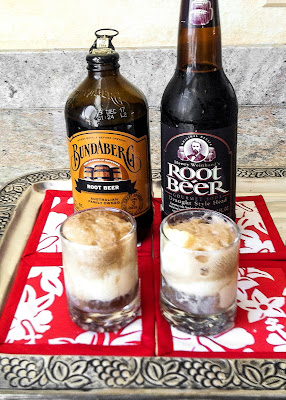"Why the surprise notation in the title?" you ask. Ah, there's a long history behind this all-American classic, and a short tale behind my root beer float today.
Some sources claim that root beer was first manufactured, bottled and sold in 1880 and the first root beer float followed some thirteen years later. Frank Wisner of Cripple Creek, Colorado noticed that the snowy peaks on Cow Mountain looked like ice cream floating in soda. The following day he floated a scoop of vanilla ice cream to the top of his glass of root beer and invented the "black cow."
OR, on a particularly hot day in Philadelphia in 1874, Robert McCay Green ran out of ice as he served soda to his customers. He substituted ice cream instead to chill the drinks. However, many others claim to have made this creation, including one of Green's employees. No matter who first served this fizzy, foamy concoction, it has been a favorite treat for many generations.
Today it was an unplanned surprise in my kitchen. I frequently order groceries online, specify a convenient delivery time, and free up my schedule to do other things. Today's delivery should have included a 6-pack of Bundaberg ginger beer, a necessary ingredient for a batch of Moscow Mules. Instead the grocery mistakenly substituted a 6-pack of Bundaberg root beer, an entirely different flavor of soda, more sweet and less spicy, and definitely not what I had in mind for Moscow Mules.
Okay, switch over to a taste-test of dueling root beers, not a bad plan for lazing about on the deck in 80-degree weather. It only took a few sips of each to reaffirm my preference for Henry Weinhard's root beer. Bundaberg tasted sweeter, maybe too sweet, and a bit thin in flavor. Henry's, pleasantly smooth and creamy, had a somewhat stronger flavor (honey, vanilla and maybe some licorice or wintergreen) with a hint of a bite . Both root beers fizzed nicely when combined with ice cream. So, sip, taste, switch samples. Repeat. Repeat. Repeat. Yes, a valid taste test requires much sampling.
The crystalized ice cream foam remained the star of the show, frothy bubbles of carbon dioxide released when carbonated root beer and ice cream meet. The fat and foaming agents in the ice cream coat the CO2 bubbles, increasing surface tension, which allows the the bubbles to expand and produce a longer-lasting, foamy head. Technique gurus dispute the order in which ingredients should be added to a chilled glass.
- Begin with root beer, filling the glass 3/4 full, and carefully add ice cream to allow foam without overflowing.
- OR add scoop(s) of ice cream to the glass, then tilt the glass and gently pour the root beer down the side. This prevents a wasteful splash when you drop the ice cream in. Detractors say it results in a murky-looking liquid from the ice cream melting more quickly as the soda is poured over it.
Pick your method, or experiment with both. Enjoy the original, a two-ingredient classic float of root beer with vanilla ice cream, or get creative and try a few flavor additions. Maybe a splash of bourbon and a dollop of whipped cream, or kahlua with coconut ice cream, or just skim Pinterest for a gazillion more tempting combinations. Myself, I'm happy enough with the classic... with Henry Weinhard's root beer, of course.






No comments:
Post a Comment
I love to read your comments so please leave a friendly note. Comments are moderated so it may take a while to appear.